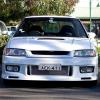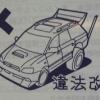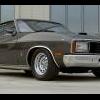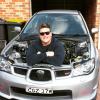
Subaru's new Liberty range is roomier and uses less fuel, despite sticking with all-wheel-drive underpinnings.
Subaru says its new Liberty and Outback models prove the company doesn’t need to move away from all-wheel-drive cars to be competitive in fuel economy.
The new-generation mid-size twins have arrived in Australia to extend Subaru’s local policy of all-wheel-drive-only vehicles into its 11th year, and both vehicles improve fuel efficiency despite being bigger and heavier.
The extra weight of all-wheel-drive hardware compared with a front-wheel-drive layout typically penalises fuel efficiency, though Subaru Australia boss Nick Senior says it’s not the case with its new medium car that starts from $33,990.
“The new Liberty helps to debunk the myth that all-wheel drive is less economical than front-wheel-drive,” says Senior. “It demonstrates that all-wheel drive and good fuel economy are not mutually exclusive.
“The Liberty’s fuel economy improvement is a great story; it’s gone from near the back of the pack to class-leading.”
A new CVT auto replaces the old four-speed auto to help improve efficiency, and teamed with the revised 2.5-litre four-cylinder horizontally opposed ‘boxer’ engine makes the Liberty’s 8.4 litres per 100km economy superior to key rivals such as the Toyota Camry, Mazda6 and Honda Accord Euro.
The naturally aspirated 2.5-litre now has a fraction less power (123kW v 127kW) but maximum torque increases slightly to 229Nm and is delivered lower in the rev range (4000 v 4400rpm).
There are also efficiency gains for the modified turbocharged version of the 2.5-litre as well as the 3.6-litre six-cylinder borrowed from the Tribeca soft-roader to replace the former 3.0-litre six. Both are mated to either a new six-speed manual or a carry-over five-speed auto.
The 2.5-litre turbo is exclusive to the sporty Liberty GT Premium model. It boasts 195kW of power, but more tantalising on paper is peak torque of 350Nm delivered from 2400 to 5200rpm. Subaru will play another fuel efficiency car in November when the company’s new 2.0-litre turbo diesel ‘boxer’ engine debuts in the Outback in November.
It will make its way into Forester next year before being considered for its non-SUV models such as Impreza and Liberty. Subaru Australia believes the Liberty’s improved fuel economy and bigger size will make the mid-sizer more appealing “The Liberty is more attractive now to fleets and governments,” says Senior, “who are becoming more aware of fuel economy and emissions and factoring them into their decision process.
“We think there is also potential for [Liberty] with large car buyers. With its extra room and range of engines, we think we can appeal to the traditional Aussie large car buyer.”
The Liberty’s enlarged back seat accommodation is achieved through a new platform that includes an 80mm-longer (2750) wheelbase. The sedan’s length and height increases by the same margin; width expands by 50mm.
Dramatically wider rear doors – up by 405mm – are designed to improve entry/egress. As with the latest Impreza, the Liberty moves away from trademark frameless doors in Subaru’s quest for improved noise refinement. Boot space also benefits from the larger dimensions.
The sedan’s luggage capacity increases by 47 litres to 476L; the wagon’s by 31 to 490L – expandable to 1690L (up 64 litres) with split-fold rear seats not found in sedan.
The new Liberty joins its fellow Subarus in attaining a maximum, five-star independent crash rating. Standard safety equipment for all models includes stability control and seven airbags (including driver’s knee airbag). Subaru says a new ‘engine cradle’ – which mounts the engines to the Liberty’s body – improves crash energy absorption, as well as benefiting ride comfort and road-holding.
Most Liberty models are either unchanged or slightly cheaper compared with their respective predecessors, though Subaru has increased the medium car’s equipment lists. All Libertys feature (switchable) hill-hold assist, electronic parking brake, cruise control, foglights, DataDot security and, of course, the all-wheel drive system that will continue to be one of Subaru’s distinctions for some years yet.
“[The all-wheel-drive-only policy] has been a winning formula for us,” says Subaru’s Senior. “It would take exceptional circumstances to change that.”
Quick Guide: 2009 Subaru Liberty Range
2.5i
$33,990 is the minimum starting point for Liberty, for a 123kW 2.5-litre engine with six-speed manual. CVT auto (with paddleshifts) adds $2500 to the price; wagon costs $2000 extra.
Standard features include seven airbags, stability control, hill-hold assist, electronic parking brake, foglights, dual-zone climate control, trip computer, leather steering wheel, and 6-CD Kenwood audio.
2.5i Premium
Higher-spec version of 2.5i is CVT only and starts at $39,990 for sedan, $41,990 for wagon. Additional features for extra $3500 over base 2.5i: electric sunroof, leather upholstery, electrically adjustable driver’s seat, and rear air vents. For an additional $2500 premium, a Premium Sat-Nav trim level brings (obviously) satellite navigation, Bluetooth, single disc DVD/CD player, and reverse-parking camera.
2.5i Sports
Effectively a GT without the turbocharged engine. Same 123kW 2.5-litre as entry-level Liberty, but for higher starting price of $39,490 comes standard with alloy pedals, firmer (Bilstein) dampers, carbon-fibre-effect trim, a dash of leather for doors, 18-inch alloy wheels, xenon headlights, and sportier-looking bumper and grille. Premium and Premium Sat-Nav trim levels introduce similar additions to Premium version, with some minor variations. Sports also available as wagon variant.
GT Premium
Range-topping Liberty kicks off at $52,990 for six-speed manual sedan. There’s a $2000 premium for both a five-speed auto and wagon body style. Power comes from a turbocharged version of the 2.5-litre four-cylinder, lifting outputs to 195kW and 350Nm. Satellite navigation is standard on all GTs, as are Bluetooth, McIntosh audio, rain-sensing wipers, electric sunroof, leather seats, reverse-parking camera, xenon headlights, 18-inch alloy wheels, Bilstein suspension, electrically adjustable front seats, and adaptive throttle sensitivity.
3.6R Premium
Sedan-only 3.6R exchanges old 3.0-litre six-cylinder for a 3.6-litre six from the Tribeca soft-roader. Power rises 11kW to 191kW, torque increases by 53Nm to 350Nm. Five-speed auto only. Standard equipment virtually identical to GT’s sans sporty suspension and body kit.
Outback
The ‘Liberty’ for buyers planning – or feigning – to venture frequently off road. Outback is mechanically identical to Liberty, but is wagon only and features tougher-looking body work and a higher ride height. Pricing starts at $37,990 for a model powered by the 123kW 2.5-litre four-cylinder, or from $48,490 for the 3.6-litre six-cylinder.

Unlike GT's predecessor, the GT Spec.B, the five-speed auto is both the faster and more fuel efficient version.
The manual gearbox is no longer the way to go with Subaru’s range-topping sports sedan (or wagon).
Unlike the GT Premium’s predecessor, the GT Spec.B, the five-speed auto is both the faster and more fuel efficient version.
Subaru claims the $54,990 GT auto is eight-tenths quicker than the $52,990 six-speed manual version in the 0-100km/h sprint (6.2 v 7.0sec); the official fuel consumption figures say the auto consumes slightly less premium unleaded (9.7 v 9.8 litres per 100km).
The auto may only have five ratios when many cars are moving to six, but they seem to be all it needs. There’s a tremendous amount of torque on tap with the 2.5-litre four-cylinder thanks to a modified turbocharger (including larger intercooler and compressor).
Torque (like power; up from 184 to 195kW) is only incrementally improved over the GT’s predecessor. But where the Spec.B’s 339Nm maximum torque arrived at 3600rpm, the new GT’s 350Nm is delivered to all four wheels from 24000 to 5200rpm (peak power kicks in just 400 revs later).
The on-paper promise translates to on-road heroics. The GT’s mighty mid-range means lower gears are rarely called upon on flowing country roads, the engine pulling strongly from above 2000rpm in top (fifth) gear.
The five-speed auto is a willing partner with its smooth shifts, and it also blips the throttle automatically when the driver downshifts using the steering wheel-mounted paddles. GT’s Bilstein suspension - including inverted struts as on the Impreza STI designed for enhanced road-holding – delivers good body control around corners and over dips and bumps, yet it also dispatches high-speed potholes and bumps with aplomb.
The traction benefits of the Liberty’s all-wheel-drive system were also obvious during the wet launch drive (Subaru’s prayers to the rain gods had been answered).
As with all new Libertys, there’s an improved driving position thanks to a steering wheel that adjusts for reach now as well as height. The front seats would welcome some extra under-thigh support, though.
There’s just one trim level for the GT Premium, whether you choose manual or auto, sedan or wagon (latter a $2000 premium). Standard features include satellite navigation, Bluetooth, McIntosh audio, leather sports seats, 18-inch alloy wheels, xenon headlights, reverse-parking camera, electrically adjustable driver’s seat.
Every new Liberty features hill-hold assist, electronic parking brake, cruise control, foglights, stability control and seven airbags (fronts, sides, curtains and driver’s knee) as standard.

Think of the 2.5i Sports as a GT Lite.
It’s for buyers looking for a sporty Liberty but can’t stretch to the GT Premium’s $52,990 starting price.
You don’t get the 195kW turbocharged version of Subaru’s 2.5-litre four-cylinder, though from $39,490 the Sports offers other key GT performance elements such as Bilstein suspension and 18-inch alloy wheels.
The Sports also gains sports bumper and grille, alloy pedals and xenon headlights. Unlike the GT, the Sports isn’t available with a six-speed manual – and it gets a continuously variable transmission (CVT) auto instead of the carry-over conventional five-speed auto.
The CVT is far more effective than the old four-speed auto. Acceleration is seamless courtesy of the gear-less transmission, though where most CVTs have a characteristic drone as constant revs are held during acceleration the Liberty’s tacho needle climbs correspondingly with vehicle speed before settling at lower revs once the car is cruising.
Drivers can use paddleshifters to change between the six artificial gears programmed into the CVT, though the transmission changes up at about 6000rpm rather than holding ‘gears’ to the 6400rpm redline.
The engine is respectably muscular, although you often have to strain your ears to catch the signature ‘boxer’ engine’s throb. And in performance terms, there’s no comparison with the GT’s terrific turbo engine (see separate first drive).
Although the Sports sits on the stiffer Bilstein dampers, the difference in suspension firmness compared to the regular underpinnings is not night and day. Although a definite verdict will have to wait until we’ve tested the new Liberty on our own choice of roads, suspension compliance seems to be excellent on all models we tested during the launch.
The Liberty Sports also tackled flowing country roads well, though the lack of tight corners on the launch drive means a full dynamic assessment must wait. The Sports is available in three trim levels (regular, Premium or Premium with Sat Nav) and two body styles (sedan or wagon).
Premium adds $4000 to the price tag ($43,490) and introduces an electric sunroof, leather seats, and electrically adjustable driver’s seat with lumbar support. Satellite navigation is an obvious inclusion for the $46,990 Premium with Sat Nav, though there’s also Bluetooth, McIntosh audio system, reverse-parking camera, dual electric front seats, and rear air vents.
The Liberty’s interior is undeniably a smart design, including brushed-metal effect trim, though overall material quality isn’t a step forward over the old model. The dash, for example, features no tactile, soft-touch plastics.
The wagon costs an additional $2000 over sedan versions. That brings improved practicality, however, as the sedan doesn’t feature folding rear seats. Every new Liberty features hill-hold assist, electronic parking brake, cruise control, foglights, stability control and seven airbags (fronts, sides, curtains and driver’s knee) as standard.

Subaru's fourth generation Outback soft-roader has more distinctive looks and has grown dramatically in cabin size in an attempt to re-establish its place in the company's expanding line-up.
Subaru Australia managing director Nick Senior admitted the just-superseded third generation Outback suffered because it looked too much like its technical blood brother, the Liberty wagon. Also, the Outback has lost sales to the latest and significantly enlarged Forester compact four-wheel-drive introduced in early 2008.
Primarily, the new Outback is differentiated from the just-launched fifth generation Liberty by its three-bar grille (versus one-bar), 83mm higher ride height and the signature off-roader black cladding that runs in a strip around the lower body. The actual sheetmetal of the two cars is identical.
"I think the first and second generation Outbacks hit the mark but I think the third generation ... was probably too close to the Liberty wagon," Senior admitted. "So the development of this one was to clearly try and establish something with a clearer identity, its own character and its own personality.
"So when you see the two together there are clear differences ... I think we have certainly achieved that."
Thanks to a 75mm increase in wheelbase and 50mm increase in width Subaru is also claiming a series of massive interior space improvements for Outback. Rear legroom is the largest gain, increasing 99mm. But boot space also expands 31 litres to 490 litres, ballooning to 1690 litres with the rear seats split-folded.
"The Forester's growth certainly blurred the gap between it and Outback, which can be seen in the sales over the last 12 months," said Senior. "Having greater space in the Outback gets that differentiator back."
But while the measurements have grown, pricing is unchanged and fuel economy (and therefore emissions) of the 'boxer' four- and six-cylinder petrol engine line-up has been reduced. Pricing and fuel economy of the 2.0D turbo-diesel - a first for Subaru in Australia - has yet to be announced as that Outback won't be launched until November.
Pricing ranges from $37,990 for the base model 2.5i manual through to $55,990 for the top-of-the-range 3.6R with satellite-navigation (full pricing listed at the bottom of the story). And yes, that's not a misprint, the boxer six-cylinder version of the Outback has grown from 3.0-litres to 3.6-litres.
The same engine is already employed by the Tribeca medium SUV and has been adopted in the latest Liberty too. The most economical Outback is the 2.5i when teamed with a newly-developed CVT Subaru labels 'Lineartronic'. It averages 8.4L/100km on the official combined cycle, compared to 9.5L/100km for the old four-speed auto it replaces.
With a new six-speed replacing the old five-speed, the manual 2.5i drops to 8.9L/100km, from 9.3L/100km. The engine also drops in power from 127kW to 123kW in the process, but rises in torque from 226Nm to 229Nm and delivers it over a wider spread.
Despite the rise in capacity, power (11kW to 191kW) and torque (11Nm to 350Nm), the 3.6R/five-speed auto combination drop from the 3.0's 11.1L/100km to 10.3L/100km. All Outbacks now come with seven airbags including a driver's knee airbag, a five star ANCAP crash test rating, stability and traction control and ABS with EBD and brake assist.
Other safety intitiatives include larger brake discs and calipers and a new cradle frame that slides the engine under the passenger cell in a head-on accident. The double wishbone self-levelling rear suspension has also been revised for improved traction. Manual Outbacks continue to come with a viscous coupled permanant all-wheel drive system, while autos employ a hydraulic clutch system.
There are three 2.5i and two 3.6R equipment grades. Interior design is overhauled including new seats and steering wheel. Dual zone climate control, an electric parking brake, six CD audio, cruise control, a trip computer, a rear-seat auto-fold function, alloy wheels and DataDot security identification are all standard across the range.
The 2.5i Premium adds an electronic sunroof, leather trim and rear air-conditioning vents. The 2.5i with SatNav adds Bluetooth, DVD/CD player, a reversing camera, a three-pin auxiliary jack and - obviously - satellite navigation. 3.6R features include push-button start, light-sensing headlights, rain-sensing wipers, Xenon low beam headlights and the three-mode SI-Drive throttle and transmission adjustment.
The top-spec 3.6R with SatNav gets the same gear as the 2.5i SatNav plus a McIntosh sound system and powered front seats. Subaru estimates the petrol Outbacks will claim around 400 sales per month, split 50:50 between fours and sixes. It believes the manual-only diesel will average around 100 sales per month. That totals up to about 6000 sales per annum, or what Outback sold consistently through the mid-2000s.
Price list
Outback 2.5i manual $37,990
Outback 2.5i Lineartronic CVT automatic $40,490
Outback 2.5i Premium manual $41,490
Outback 2.5i Premium Lineartronic CVT automatic $43,990
Outback 2.5i Premium with SatNav manual $43,990
Outback 2.5i Premium with SatNav Lineartronic CVT automatic wagon $46,490
Outback 3.6R automatic wagon $48,490
Outback 3.6R with SatNav automatic wagon $55,990
Outback 3.6R automatic wagon $48,490 Outback 3.6R with SatNav automatic wagon $55,990

Car companies usually hope for great weather at car launches.
But when the grey cloud and rain descended over the Daylesford region in central Victoria during this week's launch of the fourth generation Subaru Outback soft-roader, the gang in blue shirts were all-smiles.
All-wheel drive has been a heavily promoted feature of all Subarus sold in Australia since 1998 so what better conditions to show it off in than wet, muddy, slippery, bumpy, rutted, narrow roads. The Outback pioneered the cross-over genre back in 1996 and has honed it through three generations.
The latest Outback is bigger and heavier as it seeks to redefine itself within the Subaru line-up (see separate story), but there's no doubt it remains one of the best combinations of traditional wagon and compact SUV going around.
Apart from the fact that the Outback has been up-sized, there are several other new technical highlights; the teaming of a new six-speed manual and optional CVT with a mildly refined version of the ubiquitous boxer 2.5-litre four-cylinder engine; the six-cylinder engine grows from 3.0 to 3.6-litres; fuel economy is improved as is performance; a new platform includes a body-strengthening engine cradle up-front and revised double wishbone suspension at the back; dampers are re-valved and brakes are bigger.
Note that all-wheel drive hasn't been upgraded or altered in any significant way, apart from the limited slip diff being deleted and replaced by an electronically-controlled braking function within the standard stability control system (VDC).
Subaru now offers three 2.5i and two 3.6R grades, pricing stays steady between $37,990 and $55,990 and baseline standard equipment includes seven airbags, a five-star ANCAP independent crash rating, cruise control, six-CD audio and alloy wheels. There is an argument these days that well-tuned stability control combined with front-wheel drive effectively kill off the need for AWD.
The fuel consumption advantages of FWD over the heavier weight and frictional losses of AWD add credence to that. However, in mucky conditions the Outback felt supremely secure. The few times the AWD system couldn't quite rein in the wheels, VDC over-rode the situation to bring everything back into line.
And as for fuel consumption, Subaru points to its substantial economy improvements - up to 11.6 per cent in the 2.5i Lineartronic (CVT) compared to the old four-speed auto - to prove it can have AWD and frugality too. Happily, Lineartronic is not only less thirsty than the old auto it is also much calmer, its chain-driven variable pulleys providing almost seamless acceleration.
However, it cannot disguise the boxer engine's lack of low-down torque, so plenty of revs are required when searching for quick acceleration from the line or punching up hills. Subaru has sacrificed a little efficiency so Lineartronic actually repsonds to throttle pressures and varies engine load. But it's only marginally less monotonous than a normal CVT.
By comparison the six-speed manual is an orthodox experience. It provides a smoother shift courtesy of a cable replacing the old mechanic link, but it is not particularly fast. Lineartronic feels a nicer way to exploit the engine. The growth in size of the six-cylinder ensures its is the definite powerplant choice if you have the extra dollars. It is deep chested and flexible for a boxer, and works neatly with a traditional five-speed auto.
The SI-Drive system enables the drivetrain to operate in economical (I), normal (S) or sport (S#) modes. Alternatively, you could christen them calm, responsive and frantic. Perhaps the 3.6R is not quite as direct and accurate in its steering as the 2.5i, but either version is dynamically terrific for a compact SUV (as the Outback is officially classified).
Its technical basis as an increased-ride-height Liberty wagon is obvious. But this handling prowess has not been achieved at the cost of ride quality, which achieves a neat balance beween comfort and control. Local testing over the last 12 months has proved crucial in arriving at refined settings for dampers, springs and sway bars. And it shows. There's also evidence that this is a quieter cabin than before.
Engine and road noise seem quite muted, although the CVT creates a more notable whine than traditional autos. But sitting inside, the over-riding impression is of space and lots of it. In the back, where tall people previously feared to sit, there is now sprawling space in all directions. In the boot there is plenty of storage, around the cabin there are up-sized door pockets, cupholders and seat pockets.
There is ease of access thanks to the wider-opening framed doors and versatility too in the way the rear seats can be split-folded via levers in the boot and the steering wheel reach and rake adjusts. What won't win so many fans is the way the centre rear lap-sash seatbelt and child restraint hooks continue to be mounted in the rear roof, impairing vision. The right-hand A-pillar performs a similar task in tight corners.
Nor is the actual presentation of the centre console and instrument pod likely to win many fans. It looks okay, is a step up from the cheapness of the Impreza small car and is less wacky than the 'melted' Tribeca, but not even the top-spec 3.6R gives off a real sense of prestige. And, finally, there's the exterior. Okay, styling is subjective but the long overhangs, peeled headlights and over-sized and over-styled wheel arches seem a contrivance compared to some of the simpler, cleaner Outback bodyshapes that have gone before.
Not that Subaru Australia managing director Nick Senior was having a bar of it: "I've heard the comments about Impreza styling and that's selling stronger than it ever has. There were comments about Forester and that's been the biggest selling compact SUV of the last 18 months. I just don't think it's an issue."
all info take from: http://www.smh.com.au/drive





















